Gennaro Cuofano's Blog, page 150
June 28, 2021
Price Skimming And Why It Matters In Business
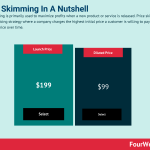
Price skimming is primarily used to maximize profits when a new product or service is released. Price skimming is a product pricing strategy where a company charges the highest initial price a customer is willing to pay and then lowers the price over time.
Understanding price skimmingThe strategy is most effective for a company with first-mover status. By generating maximum profit in the shortest time possible, the company can quickly recover its sunk costs before competition and pricing pressures increase.
Price skimming is sometimes described as riding down the demand curve as the business seeks to capture consumer surplus early in the product life cycle to exploit its first-mover position. The product is initially offered at a high price targeting consumers with the desire or required funds to purchase it.
As demand and the novelty of the product decreases, the price is lowered to capture consumers with the next highest level of desire and purchasing ability. This process may be repeated multiple times until the pricing levels off at a base price. In theory, the business “skims off” the top of each level since it charges the maximum price consumers in each level are willing to pay.
Price skimming is closely related to the diffusion of innovation, a theory explaining the rate at which a new product spreads through a social system. Initially, price skimming targets the innovators – a group of risk-taking consumers who want first access to a product no matter the price.
Examples of price skimmingPrice skimming can be seen in any scenario with one or more of the following characteristics:
The presence of a target audience willing to buy the product at a higher price – the so-called innovators of the diffusion of innovation theory.A general belief among consumers that a higher price is associated with higher quality.A general belief that higher prices do not attract significant competition.A view that lowering the price would have a minor effect on increasing sales volume and reducing unit costs.Real-world examples of price skimming in action include:
Smartphones – when Samsung releases a new smartphone, the company sets a higher price when initial demand is high and then progressively lowers the price as hype begins to wane. Sports apparel – Nike also employs a similar strategy when it releases a range of new or limited edition shoes. Where Samsung relies on exclusivity and innovation to attract premium buyers, Nike relies more on brand equity. Gaming consoles – Sony is well known for releasing its PlayStation line of gaming consoles at a high price and progressively lowering it over time. In fact, the company sold more PlayStation 4 consoles in the third and fourth years after release than it did in the first two years.Advantages and disadvantages of price skimmingAdvantagesReturn on investment – higher price points in conjunction with lower supply help a business recoup its costs and deliver a superior ROI. This is particularly beneficial for companies that invest heavily in research and development.Brand image – innovators who gain early access to a new product are not just gaining access to the product itself. There is often novelty, prestige, and superiority involved with owning a new product. This causes consumers to associate positive feelings or emotions with certain brands.DisadvantagesAlienation of consumers – unfortunately, emotions can also damage a brand. This occurs when innovators see that a product they paid top dollar for is being offered to the masses for a discounted price. Aside from the obvious financial disadvantage, the innovator loses some degree of exclusivity as the product they bought becomes more mainstream.Not applicable to all industries or companies – for whatever reason, some businesses will simply not have the ability to implement price skimming. Luxury goods manufacturers could not progressively discount their products for fear of having their range seen as lower quality by consumers.Key takeaways:Price skimming is a product pricing strategy for businesses with the first-mover status that want to target consumers willing to pay a high price for a product. The price is then progressively lowered over time to target new customer segments.Price skimming is employed by companies such as Nike, Sony, and Samsung, among others. The presence of consumers willing to pay a high price for early access is critical to the success of each company’s strategy.Price skimming delivers a superior ROI and increases brand equity. However, it can alienate first adopters and does not apply to some industries or businesses. A pricing strategy or model helps companies find the pricing formula in fit with their business models. Thus aligning the customer needs with the product type while trying to enable profitability for the company. A good pricing strategy aligns the customer with the company’s long-term financial sustainability to build a solid business model.
A pricing strategy or model helps companies find the pricing formula in fit with their business models. Thus aligning the customer needs with the product type while trying to enable profitability for the company. A good pricing strategy aligns the customer with the company’s long-term financial sustainability to build a solid business model. Read Next: Pricing Strategies, Dynamic Pricing, Is First Mover Advantage a Myth?
Main Free Guides:
Business ModelsBusiness StrategyBusiness DevelopmentDigital Business ModelsDistribution ChannelsMarketing StrategyPlatform Business ModelsRevenue ModelsTech Business ModelsBlockchain Business Models FrameworkThe post Price Skimming And Why It Matters In Business appeared first on FourWeekMBA.
What Is Newsjacking And Why It Matters In Business
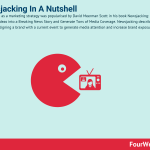
Newsjacking as a marketing strategy was popularised by David Meerman Scott in his book Newsjacking: How to Inject Your Ideas into a Breaking News Story and Generate Tons of Media Coverage. Newsjacking describes the practice of aligning a brand with a current event to generate media attention and increase brand exposure.
Understanding newsjackingNewsjacking differs from a publicity stunt in that the news item is leveraged in the marketing campaign and not in a public venue or place of business. Essentially, the company employing newsjacking as a strategy is piggybacking off of a newsworthy event and the large amount of discussion these events generate.
A decade or so ago, businesses would attempt to use the strategy during large, televised events such as the Super Bowl or Academy Awards. With many consumers becoming desensitized to traditional forms of advertising, newsjacking has moved to social media and other online channels.
Newsjacking and the life of a news storyMeerman argues that for newsjacking to be effective, timing is everything. Ideas must be injected into a breaking news story at a precise moment to encourage viral spread.
One way to visualize the life of a news story is to consider a bell curve with time on the x-axis and interest level on the y-axis. The first key point on the curve is where the news breaks. Here, there are low-interest levels because a small amount of time has elapsed and the story has not reached a lot of the population.
As more time passes, interest levels grow. This causes journalists to scramble for additional information about the story which in turn causes an increase in public interest. For businesses, the ideal time to insert their marketing message is between the point where the news breaks and the point where it is picked up by the media.
As the media reports on the who, what, when, and where of the story, they often struggle with the why. In other words, the implications of the event. Marketing strategists who are clever enough to get in at this point add the story of their own brand to the wider news story. In essence, the news and brand become inseparable as the business associates itself with the event via a blog post, tweet, media alert, or press release.
Real-world examples of newsjackingHere are three real-world examples of companies successfully employing newsjacking:
Oreo and the 2013 Super Bowl blackoutWhen the 2013 Super Bowl suffered an electricity outage for approximately 30 minutes, biscuit company Oreo tweeted that sports fans could still “dunk in the dark”. The tweet amassed over 16,000 re-tweets because the marketing team was able to respond to a farcical situation with brevity and wit.
Mashable and the 2015 Golden GlobesDigital media giant Mashable wrote a timely article about crafting Golden Globe cocktails at home in the lead-up to the 2015 awards. This allowed award fans to drink like their favorite celebrities and increased brand exposure for Mashable.
 Source: MashableKit Kat and the iPhone 6
Source: MashableKit Kat and the iPhone 6 When the iPhone 6 launched in 2014, many Apple fans complained about a tendency for the smartphone to bend while in their back pockets. In response, the company released a tweet remarking “We don’t bend, we #break.” The tweet represented a subtle dig at Apple but was not so offensive that it started a brand war. The tweet has since been reposted over 22,000 times.
 Source: Kit Kat TweetKey takeaways:Newsjacking involves a brand or business mentioning or creating a separate campaign around a major news event. The strategy leverages news exposure to increase brand awareness.Newsjacking was most often used during televised events such as the Super Bowl. As consumers have become savvier, efforts are now mostly focused on social media.Biscuit maker Oreo used newsjacking to capitalize on an electricity outage during the 2013 Super Bowl.
Source: Kit Kat TweetKey takeaways:Newsjacking involves a brand or business mentioning or creating a separate campaign around a major news event. The strategy leverages news exposure to increase brand awareness.Newsjacking was most often used during televised events such as the Super Bowl. As consumers have become savvier, efforts are now mostly focused on social media.Biscuit maker Oreo used newsjacking to capitalize on an electricity outage during the 2013 Super Bowl.Main Free Guides:
Business ModelsBusiness StrategyBusiness DevelopmentDigital Business ModelsDistribution ChannelsMarketing StrategyPlatform Business ModelsRevenue ModelsTech Business ModelsBlockchain Business Models FrameworkThe post What Is Newsjacking And Why It Matters In Business appeared first on FourWeekMBA.
Goodhart’s Law And Why It Matters In Business
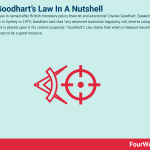
Goodhart’s Law is named after British monetary policy theorist and economist Charles Goodhart. Speaking at a conference in Sydney in 1975, Goodhart said that “any observed statistical regularity will tend to collapse once pressure is placed upon it for control purposes.” Goodhart’s Law states that when a measure becomes a target, it ceases to be a good measure.
Understanding Goodhart’s LawGoodhart would later admit that his quip was intended to be a humorous, throw-away comment. But it was nevertheless an accurate and perceptive observation about how the modern world functions.
It’s important to note that Goodhart himself had no role in naming the law for which he is named. That distinction goes to anthropologist Marilyn Strathern, who argued in a 1997 paper that the law had uses beyond statistics to evaluation in a broader sense.
An oft-told story of Goodhart’s Law at work can be described by the cobra effect. In India under British colonial rule, the government was troubled by the number of venomous cobras. To reduce their population, the government placed a bounty on every cobra the locals could catch. This strategy worked for a while, but some individuals began breeding the cobras only to kill them later and collect a higher bounty.
Eventually, the colonial government caught on and scrapped the scheme, causing many of the bred cobras to be released into the wild. The key takeaway of the cobra effect story is that incentives designed to solve a problem end up rewarding people for making the problem worse.
The four forms of Goodhart’s LawThere are generally accepted to be four variations on Goodhart’s Law:
Regressive Goodhart – here, the measures individuals use for their target (goal) are imperfectly correlated with that goal. For example, weight is imperfectly correlated with health because it encourages skipping meals or weighing oneself in the morning with an empty stomach.Extremal Goodhart – this occurs when a measurement is picked because it correlates with a goal in normal situations. In extreme circumstances however, the measure is erroneous. The human relationship with sugar is a classic example. While sugar was correlated with survival thousands of years ago, the same cannot be said of modern, sedentary lifestyles where sugar promotes obesity.Causal Goodhart – where the behavior of an individual does not directly affect the goal but has some causal effect on the measure. The number of times a gym membership is renewed does not directly impact how often an individual exercises, for example.Adversarial Goodhart – where other goals confound the goal a measure is trying to accomplish, such as the cobra effect mentioned above.Avoiding the impact of Goodhart’s LawOf the four variations of Goodhart’s Law, only the Regressive Goodhart is unavoidable.
For the remaining three, here are some simple avoidance tips:
Conduct regular checks to ensure the measure is still incentivizing in line with the desired outcome or goal.Become aware of Goodhart’s Law and how it operates.Maintain a focus on the end goal while using the measures as a guide only.Reduce bureaucracy and formalism.Use a combination of diversified metrics. A balanced scorecard can be useful here.Key takeaways:Goodhart’s Law states that when a measure becomes a target, it ceases to be a good measure.Goodhart’s Law was informally coined during a speech by Charles Goodhart. Although the economist was speaking in the context of statistics, the law has broader evaluative applications.Goodhart’s Law is generally categorized into four variations: Regressive Goodhart, Extremal Goodhart, Causal Goodhart, and Adversarial Goodhart.Related Visual Concepts:
 Maslow’s Hammer, otherwise known as the law of the instrument or the Einstellung effect, is a cognitive bias causing an over-reliance on a familiar tool. This can be expressed as the tendency to overuse a known tool (perhaps a hammer) to solve issues that might require a different tool. This problem is persistent in the business world where perhaps known tools or frameworks might be used in the wrong context (like business plans used as planning tools instead of only investors’ pitches).
Maslow’s Hammer, otherwise known as the law of the instrument or the Einstellung effect, is a cognitive bias causing an over-reliance on a familiar tool. This can be expressed as the tendency to overuse a known tool (perhaps a hammer) to solve issues that might require a different tool. This problem is persistent in the business world where perhaps known tools or frameworks might be used in the wrong context (like business plans used as planning tools instead of only investors’ pitches).  The Peter Principle was first described by Canadian sociologist Lawrence J. Peter in his 1969 book The Peter Principle. The Peter Principle states that people are continually promoted within an organization until they reach their level of incompetence.
The Peter Principle was first described by Canadian sociologist Lawrence J. Peter in his 1969 book The Peter Principle. The Peter Principle states that people are continually promoted within an organization until they reach their level of incompetence.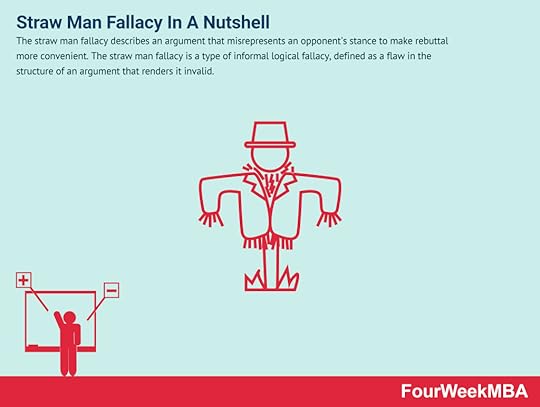 The straw man fallacy describes an argument that misrepresents an opponent’s stance to make rebuttal more convenient. The straw man fallacy is a type of informal logical fallacy, defined as a flaw in the structure of an argument that renders it invalid.
The straw man fallacy describes an argument that misrepresents an opponent’s stance to make rebuttal more convenient. The straw man fallacy is a type of informal logical fallacy, defined as a flaw in the structure of an argument that renders it invalid. The Streisand Effect is a paradoxical phenomenon where the act of suppressing information to reduce visibility causes it to become more visible. In 2003, Streisand attempted to suppress aerial photographs of her Californian home by suing photographer Kenneth Adelman for an invasion of privacy. Adelman, who Streisand assumed was paparazzi, was instead taking photographs to document and study coastal erosion. In her quest for more privacy, Streisand’s efforts had the opposite effect.
The Streisand Effect is a paradoxical phenomenon where the act of suppressing information to reduce visibility causes it to become more visible. In 2003, Streisand attempted to suppress aerial photographs of her Californian home by suing photographer Kenneth Adelman for an invasion of privacy. Adelman, who Streisand assumed was paparazzi, was instead taking photographs to document and study coastal erosion. In her quest for more privacy, Streisand’s efforts had the opposite effect. Main Free Guides:
Business ModelsBusiness StrategyBusiness DevelopmentDigital Business ModelsDistribution ChannelsMarketing StrategyPlatform Business ModelsRevenue ModelsTech Business ModelsBlockchain Business Models FrameworkThe post Goodhart’s Law And Why It Matters In Business appeared first on FourWeekMBA.
June 27, 2021
The Compromise Effect And Why It Matters In Business
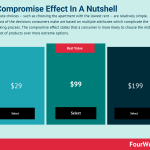
Single-attribute choices – such as choosing the apartment with the lowest rent – are relatively simple. However, most of the decisions consumers make are based on multiple attributes which complicate the decision-making process. The compromise effect states that a consumer is more likely to choose the middle option of a set of products over more extreme options.
Understanding the compromise effectConsumers are faced with a multitude of choices every day. Single-attribute choices – such as choosing the apartment with the lowest rent – are relatively simple. However, most of the decisions consumers make are based on multiple attributes which complicate the decision-making process.
For example, selecting a rental apartment can also be based on commute time and the availability of off-street parking. Should the consumer choose an apartment that is close to work or school? Should they sell their car and choose the option without parking? Or should they choose based on price only? Traditional rational choice theory argues that consumers will make the decision that yields the most value.
But research has shown the theory is not always applicable in complex decision-making situations. Consumers find it difficult to assess or compare the relationship between various attributes which hinders their ability to make a rational decision.
This is where the compromise effect is useful. Instead of making an extreme decision based on one option only, the apartment searcher compromises by choosing a mediocre option in the middle. For example, they may choose an apartment within their price range but with a long commute time and a lack of off-street parking. Conversely, they may choose an apartment with a short commute time but compromise by paying more rent. Note that the mediocre option does not necessarily mean it is inferior.
Businesses can also use this tendency for consumers to select a mediocre option by offering two extremes. In truth, this tactic is employed everywhere. Car dealerships always offer a budget, mid-range, and premium model line. Liquor stores offer cheap wine on the bottom shelf grading to more expensive wine on the top shelf. Mattress companies offer three versions of the same mattress with various added features.
What causes the compromise effect?Various theories have been put forth on what causes the compromise effect by scholars.
Here are some common perspectives:
The perspective of seeking reasons – some believe consumers unable to choose between products with various attributes are seeking to reduce conflict and dissonance. By providing a valid reason for their own choice, it is thought consumers can then justify their choices to others and be positively judged.The perspective of loss aversion – there is often uncertainty around the consequences of making a decision and also the future consequences once it has been made. Here, the compromise effect helps consumers choose an option they believe will minimize potential errors. These options are commonly the safest option a consumer will regret making the least. Furthermore, the attractiveness of an option if it is the middle option between two extremes is enhanced. By extension, the attractiveness of the extreme options is reduced because they represent more risk.The perspective of rational decision-making – while this article makes the distinction between rational decision-making theory and the compromise effect, some scholars argue the two phenomena are linked. In other words, the compromise effect is a form of rational inference made by consumers based on market data. More specifically, these inferences are based on commodity information provided by the market to predict product utility. When a consumer understands a product relative to other products, they make a better decision based on the hierarchical nature of each product in the set.Key takeaways:The compromise effect argues a consumer is more likely to choose the middle option in a product set over more extreme options.The compromise effect is most applicable in situations where a consumer has to compare multiple attributes for a single decision. An inability to compare these attributes effectively leads to the selection of a mediocre (though not necessarily inferior) option.Research suggests the compromise effect is caused by several factors. Some argue the effect helps consumers reduce internal conflict and enables them to better explain their choices to others. Other scholars believe the effect is primarily a risk mitigation strategy.Main Free Guides:
Business ModelsBusiness StrategyBusiness DevelopmentDigital Business ModelsDistribution ChannelsMarketing StrategyPlatform Business ModelsRevenue ModelsTech Business ModelsBlockchain Business Models FrameworkThe post The Compromise Effect And Why It Matters In Business appeared first on FourWeekMBA.
Paradigm Shift And Why It Matters In Business
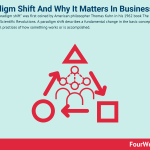
The term “paradigm shift” was first coined by American philosopher Thomas Kuhn in his 1962 book The Structure of Scientific Revolutions. A paradigm shift describes a fundamental change in the basic concepts and experimental practices of how something works or is accomplished.
Understanding a paradigm shiftThe term “paradigm shift” was first coined by American philosopher Thomas Kuhn in his 1962 book The Structure of Scientific Revolutions.
Kuhn used the term to articulate his views about how science changes over time, arguing that it does not evolve gradually toward a truth. He was inspired by psychologist Jean Piaget, who described children’s development as a series of discrete stages punctuated by transitional periods.
As a result, Kuhn put forth two kinds of scientific change:
So-called normal science, which Kuhn argues is scientific work done within the bounds of an existing paradigm theory. Examples of these theories include electromagnetism, Darwin’s theory of evolution, and Newtonian physics.Scientific revolution, or periods of rapid development within normal science but resulting in paradigm shifts.Although once confined to the scientific discipline, paradigm shifts have made a seamless transition to popular culture, technology, manufacturing, and finance.
What causes a paradigm shift?Kuhn noted that for a paradigm shift to occur, scientists must first be working under a paradigm theory. This encompasses normal scientific work, including solving problems, collecting data, and making calculations.
However, normal scientific work sometimes uncovers anomalies that cannot be explained by the current paradigm. Once a certain number of anomalies have been detected, individuals begin to question the paradigm resulting in what Kuhn calls a “crisis”.
In the 18th century, the fact that some metals gained mass during combustion contradicted the phlogiston theory – or a belief that combustible metals contained a substance called phlogiston that was released via combustion. This contradiction led to a new theory being developed that combustion actually required oxygen.
In the 19th century, scientists failed to detect an invisible medium called ether which they thought explained the behavior of light and gravity. This crisis resulted in the eventual formation of the theory of relativity by Albert Einstein.
Paradigm shifts in businessParadigm shifts in business can be seen in many contexts and are usually caused by rapid advancements in technology and society.
Here is a look at some notable paradigm shifts in a business context:
Personalized marketing – historical marketing efforts focused on reaching as many people as possible through TV, print, radio, and billboard advertising. Although a more personalized form of marketing was proposed in the early 1990s, technology has only very recently allowed companies to market to individuals. Spotify and Netflix have set a high standard with their personalized content recommendations.Consumer trust – consumers now expect more brand humanity from the organizations they do business with. Stalwarts such as Macy’s and Adidas lost the trust of consumers due to a lack of transparency and data breaches. The role of trust in consumer expectations has been made doubly important in the wake of the COVID-19 pandemic. Companies such as Amazon, Google, and many food delivery companies were held in high regard for adapting their products and services within a pandemic framework. Cultural and technological change – brands that resist or ignore paradigm shifts associated with cultural or technological change are doomed to fail. Blockbuster, Nokia, and BlackBerry are all prime examples. The same can be said of horse and cart operators before the automobile attained critical mass in the early 20th century.Telecommunications – the pandemic has also caused a paradigm shift in the way we work. Companies like Zoom have benefitted tremendously from the need for remote communication capability. Perhaps more to the point, remote work is now seen as a viable alternative to working in an office in many industries.Key takeaways:A paradigm shift describes a fundamental change in the concepts or best practices of a way of operating. It was first described in the context of scientific development by Thomas Kuhn but applies to many other industries.A paradigm shift is precipitated by anomalies that cannot be explained by the prevailing paradigm theory. Multiple anomalies cause a crisis and subsequent shift in thinking.For businesses, paradigm shifts are apparent in personalized marketing, consumer trust and expectations, telecommunications, and cultural or technological change.Main Free Guides:
Business ModelsBusiness StrategyBusiness DevelopmentDigital Business ModelsDistribution ChannelsMarketing StrategyPlatform Business ModelsRevenue ModelsTech Business ModelsBlockchain Business Models FrameworkThe post Paradigm Shift And Why It Matters In Business appeared first on FourWeekMBA.
First-principles Thinking In A Nutshell
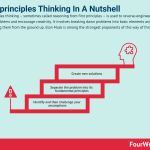
First-principles thinking – sometimes called reasoning from first principles – is used to reverse-engineer complex problems and encourage creativity. It involves breaking down problems into basic elements and reassembling them from the ground up. Elon Musk is among the strongest proponents of this way of thinking.
Understanding first-principles thinkingFirst-principles thinking has been employed by many greater thinkers over the years, including military strategist John Boyd and ancient Greek philosopher Aristotle.
In modern times, Elon Musk is the thinker most associated with the concept. When the entrepreneur attempted to source rockets for an expedition to Mars, he ran into a major challenge right away. After consulting with several companies, Musk learned the cost of a single rocket would be an astronomical $65 million.
This presented a major obstacle to his ambitions, so he used first-principles thinking to reframe the problem. “Physics teaches you to reason from first principles rather than by analogy. So I said, okay, let’s look at the first principles. What is a rocket made of? Aerospace-grade aluminum alloys, plus some titanium, copper, and carbon fiber. Then I asked, what is the value of those materials on the commodity market? It turned out that the materials cost of a rocket was around 2% of the typical price”, Musk would later remark.
Everyone knows that SpaceX was born soon after. However, the reasons for establishing the company are perhaps more interesting. Instead of spending tens of millions of dollars on rockets, Musk decided to create SpaceX so he build the rockets himself using cheaper raw materials.
Fundamentally, first-principles thinking encourages individuals to think like scientists who do not assume anything to be true. The method requires actively questioning every assumption one has regarding a problem or situation and creating new knowledge from the ground up.
Indeed, first principles can be described as basic assumptions that cannot be reduced or questioned any further. At this point, creativity and innovation begin.
Engaging in first-principles thinkingTo harness the power of first-principles thinking, simply work through the following steps:
Identify and then challenge your assumptions – the next time you are faced with a problem or challenge, write down long-held assumptions about them. If you are trying to lose weight, you might assume you don’t have enough time to do so. If you are trying to grow a business, you might assume it can’t be done without a large sum of money. Challenge your beliefs. How do you know an assumption is true? What would happen if you believed the opposite?Separate the problem into its fundamental principles – what are the most basic truths or elements of your problem? Asking powerful questions is one way to identify these truths or elements. When Musk was faced with historically expensive battery pack manufacturing, he used first-principles thinking to break the problem down. He asked himself what the constituent parts of a battery were and how much every part was worth if purchased separately on a commodities exchange.Create new solutions – with the constituent parts identified, how can they be recombined in a different way to produce something new and insightful? Someone who believes they have no time for losing weight could try less frequent, high-intensity workouts to burn fat. A budding entrepreneur could joint-venture with a high-profile player in their industry to share costs and promote themselves to a new audience. At this point, it’s important to be bold and courageous. As Musk once said, “Good ideas are always crazy until they’re not.”Key takeaways:First-principles thinking helps individuals reverse engineer complex problems and think creatively.First-principles thinking has been popularized by Elon Musk, who has used the strategy to reverse engineer the rocket and battery pack manufacturing process.First-principles thinking requires that we identify and then challenge our sometimes long-held assumptions around problems. We must then separate problems into fundamental elements and combine them in useful ways to create viable solutions.Main Free Guides:
Business ModelsBusiness StrategyBusiness DevelopmentDigital Business ModelsDistribution ChannelsMarketing StrategyPlatform Business ModelsRevenue ModelsTech Business ModelsBlockchain Business Models FrameworkThe post First-principles Thinking In A Nutshell appeared first on FourWeekMBA.
Sustainable Competitive Advantage In A Nutshell
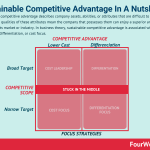
Sustainable competitive advantage describes company assets, abilities, or attributes that are difficult to duplicate or exceed. The qualities of these attributes mean the company that possesses them can enjoy a superior and long-term position in its market or industry. In business theory, sustainable competitive advantage is associated with cost leadership, differentiation, or cost focus.
Understanding sustainable competitive advantageThe business environment of today is extremely competitive, with technology and innovation allowing companies to be established with relative ease and attract consumers from all over the world.
One such example is the explosion in online retail businesses. While these are undoubtedly popular and the industry evergreen, the challenge for a new organization is to avoid becoming a copycat business with little to differentiate itself.
Harvard Business School Professor Michael Porter wrote the definitive sustainable competitive advantage textbook in 1985. Porter argued that for competitive advantage to be sustained, businesses must establish clear strategies, operations, and goals. The values of the company and corporate culture created must also be in alignment with said goals.
While he was writing the textbook, Porter researched hundreds of companies to identify what gave them a long-term competitive advantage.
In the following section, we’ll discuss the results of his research.
Three means of sustainable competitive advantage According to Michael Porter, a competitive advantage, in a given industry could be pursued in two key ways: low cost (cost leadership), or differentiation. A third generic strategy is focus. According to Porter a failure to do so would end up stuck in the middle scenario, where the company will not retain a long-term competitive advantage.Cost leadership
According to Michael Porter, a competitive advantage, in a given industry could be pursued in two key ways: low cost (cost leadership), or differentiation. A third generic strategy is focus. According to Porter a failure to do so would end up stuck in the middle scenario, where the company will not retain a long-term competitive advantage.Cost leadership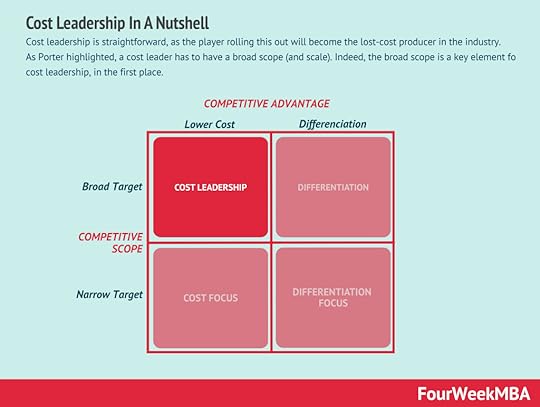 According to Porter there are three core strategies for competitive positioning: cost leadership, differentiation and focus. Cost leadership is straightforward, as the player rolling this out will become the lost-cost producer in the industry.
According to Porter there are three core strategies for competitive positioning: cost leadership, differentiation and focus. Cost leadership is straightforward, as the player rolling this out will become the lost-cost producer in the industry. Cost leadership means organizations consistently provide value at a lower price.
This means improving operational efficiency and, more often than not, paying workers less. Some companies will offset low wages with less tangible benefits such as stock options, loyalty programs, or promotional offers. Others simply take advantage of a surplus of unskilled labor and set their own wages.
Walmart and Costco are two examples of sustainable competitive advantage derived from cost leadership. These two businesses in particular use economies of scale to drive prices down to a point where other companies cannot compete.
Differentiation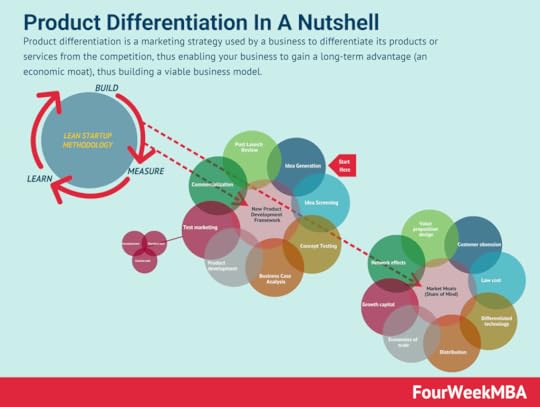 Product differentiation is a marketing strategy used by a business to differentiate its products or services from the competition, thus enabling your business to gain a long-term advantage (an economic moat), thus building a viable business model.
Product differentiation is a marketing strategy used by a business to differentiate its products or services from the competition, thus enabling your business to gain a long-term advantage (an economic moat), thus building a viable business model. In this case, the company differentiates itself by delivering better benefits than its competitors.
Differentiation can be facilitated by product quality or innovation, exemplary customer service, or rapid delivery time, among other things.
When department store Nordstrom became the first to allow item returns without question, it differentiated itself in the retail market. Jeweler Tiffany & Co. charges more for its products because its customers view its jewellery as higher quality than similar offerings.
Cost focusA business using cost focus as a sustainable competitive advantage understands and services its target market better than anyone else.
This can be achieved via cost leadership or differentiation. But more to the point, the business focuses on serving a very specific target audience and serving them well.
Community banks and credit unions use this strategy by targeting small businesses or affluent individuals. They can give a level of personal attention that would be unsustainable for a large banking institution with millions of customers on its books. Importantly, this personal touch is what the target audience craves.
Other factors that increase sustainable competitive advantageWhile Porter’s list of three traits is a good starting point, several other factors increase sustainable competitive advantage.
They include:
Branding – building a brand requires a large investment of time and money that is simply not replicable in most cases. Coca-Cola is one example of a company enjoying sustained dominance in the very competitive beverage industry.Strategic assets – companies with excellent research and development divisions tend to enjoy a sustainable competitive advantage. As a result of their efforts, they may hold patents, trademarks, and secure contracts that cannot be replicated.Geographic location – otherwise known as a national competitive advantage. Chinese firms are competitive globally because the standard of living is low in China, meaning companies can pay their workers less. The same can be said for Indian firms. In the United States, innovation is a national characteristic helping tech businesses dominate.Key takeaways:Sustainable competitive advantage describes company assets, abilities, or attributes that are difficult to duplicate or exceed. Sustainable competitive advantage was mentioned in a definitive 1985 paper by Harvard Business School Professor Michael Porter. After researching hundreds of companies, he identified three categories: cost leadership, differentiation, and cost focus.Sustainable competitive advantage can also occur because of high brand equity, strategic assets, and country-specific characteristics.Related Visual Concepts:
 Economic or market moats represent the long-term business defensibility. Or how long a business can retain its competitive advantage in the marketplace over the years. Warren Buffet who popularized the term “moat” referred to it as a share of mind, opposite to market share, as such it is the characteristic that all valuable brands have.
Economic or market moats represent the long-term business defensibility. Or how long a business can retain its competitive advantage in the marketplace over the years. Warren Buffet who popularized the term “moat” referred to it as a share of mind, opposite to market share, as such it is the characteristic that all valuable brands have.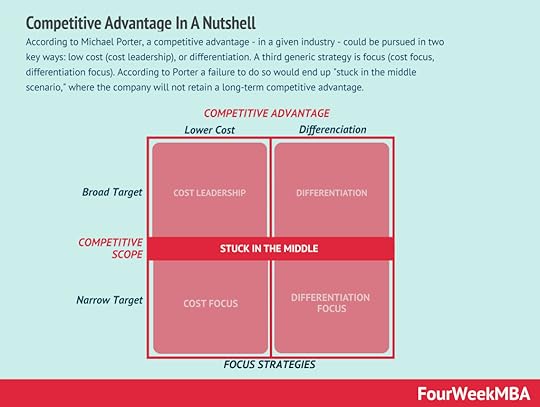 According to Michael Porter, a competitive advantage, in a given industry could be pursued in two key ways: low cost (cost leadership), or differentiation. A third generic strategy is focus. According to Porter a failure to do so would end up stuck in the middle scenario, where the company will not retain a long-term competitive advantage.
According to Michael Porter, a competitive advantage, in a given industry could be pursued in two key ways: low cost (cost leadership), or differentiation. A third generic strategy is focus. According to Porter a failure to do so would end up stuck in the middle scenario, where the company will not retain a long-term competitive advantage.Main Free Guides:
Business ModelsBusiness StrategyBusiness DevelopmentDigital Business ModelsDistribution ChannelsMarketing StrategyPlatform Business ModelsRevenue ModelsTech Business ModelsBlockchain Business Models FrameworkThe post Sustainable Competitive Advantage In A Nutshell appeared first on FourWeekMBA.
The Change Curve In A Nutshell
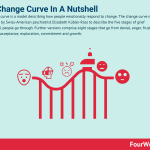
The change curve is a model describing how people emotionally respond to change. The change curve model was created by Swiss-American psychiatrist Elisabeth Kübler-Ross to describe the five stages of grief terminally ill people go through. Further versions comprise eight stages that go from denial, anger, frustration, depression, acceptance, exploration, commitment and growth.
Understanding the change curveThe change curve model was created by Swiss-American psychiatrist Elisabeth Kübler-Ross to describe the five stages of grief terminally ill people go through.
Her work was highly acclaimed, leading to the concept being adopted in the business world to define how people respond to different types of organizational change. As a result, it is still sometimes referred to as the Kübler-Ross model.
Workplaces are stressful at the best of times, with negative emotions associated with restructuring, redundancy, managerial staff, work requirements, and new technology. Many employees are simply comfortable with the status quo and actively resist change – no matter how beneficial it may be for them.
Several variations of the model now exist, but most incorporate basic emotional stages since most people react to change in more or less the same way. We will take a look at these stages in the next section and explain how they can be used to accept and even embrace change.
The eight stages of the change curveFor best results, the individual should move through the different stages of the curve linearly and as quickly as possible. Managers can also smooth the change process by understanding where each employee is on their journey and providing the appropriate support.
Here is a look at each step of the curve adapted from the original grief-based Kübler-Ross model:
Stage 1 (Denial) – the first stage of denial or shock is usually short-lived. Employees may act defensively when told that change is imminent and pretend it is not happening. This often leads to a decrease in productivity as they become fixated on the past.Stage 2 (Anger) – at some point, the gravity of the situation hits, and the employee angrily looks for someone or something to blame. Anger may be directed at colleagues, superiors, the self, or the economy. At this point, the individual becomes lost and uncertain about their future. Stage 3 (Frustration) – in the third stage, the individual tries to delay or postpone the inevitable. They may also try to negotiate a better outcome with the person instigating the change.Stage 4 (Depression) – here, the individual is despondent and experiences negative emotions such as sadness, regret, fear, and guilt. Their confidence falters and they believe everything they are doing is a waste of time.Stage 5 (Acceptance) – with time, the individual gradually comes to accept the change. With acceptance comes a genuine desire to investigate the possibilities of a new future and how to make the most of it.Stage 6 (Exploration) – as confidence begins to build, the individual becomes more enthusiastic about change. They envision themselves adapting to change by visualizing how they might benefit. They plan for a positive future and can solve the inevitable teething problems they encounter along the way.Stage 7 (Commitment) – with acceptance and planning comes commitment. The post-change environment becomes the new status quo.Stage 8 (Growth) – the growth stage is not included in many change curve models, but it is worth mentioning. In this final stage, the individual flourishes in their position and crucially is better able to deal with change the next time it occurs.The entrepreneurial rollercoasterFor entrepreneurs understanding these emotional cycles is extremely important. Indeed, the entrepreneurial journey is made of many ups and downs, and often times those happen in the same day. This is even worse for those trying to build something completely new. Therefore, it’s important to understand the emotional rollercoaster to be able to deal with it and build a successful business.
Key takeaways:The change curve is a model describing the emotional journey people undertake when responding to change.The change curve was created by psychiatrist Elisabeth Kübler-Ross to describe how terminally ill patients approach death. It has since been adapted and expanded for use in business contexts.The change curve has many variations, but an eight-stage curve is the most detailed. The eight stages are denial, anger, frustration, depression, acceptance, exploration, commitment, and growth.Main Free Guides:
Business ModelsBusiness StrategyBusiness DevelopmentDigital Business ModelsDistribution ChannelsMarketing StrategyPlatform Business ModelsRevenue ModelsTech Business ModelsBlockchain Business Models FrameworkThe post The Change Curve In A Nutshell appeared first on FourWeekMBA.
Critical Success Factors In A Nutshell
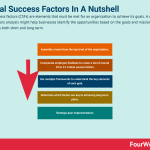
Critical success factors (CSFs) are elements that must be met for an organization to achieve its goals. A critical success factors analysis might help businesses identify the opportunities based on the goals and missions of the business both short and long term.
Understanding critical success factorsCritical success factors have a few non-negotiable characteristics.
They must:
Be synonymous with a high-level goal.Directly be linked to the business strategy.Be integral to organizational success.Benefit the individual, department, or organization as a whole.In terms of a precise definition, critical success factors are generally action phrases describing the desired result and the action itself.
For example, a company might seek to be service-oriented when working with its customers. Another may opt to work toward a higher quality order fulfillment experience through process improvements.
Regardless of the particular CSF or industry concerned, it must be stressed that the preferred course of action is aligned with organizational goals and mission.
Determining critical success factorsEstablishing a suite of critical success factors can be performed in five steps:
Assemble a team from the top level of the organization. Seniority is important to guide proper strategy and ensures there is buy-in from those with the power to make decisions. Some businesses may choose to bring in consultants to facilitate the process.Incorporate employee feedback to create a list of around 10 to 15 critical success factors. Be sure to incorporate a broad swathe of employees, backgrounds, skills, departments, and expertise.Use multiple frameworks to understand the key elements of each goal. A business may choose to use an OAS (Objective, Advantage, Scope) statement to help them describe its strategy and strategy execution. A SWOT analysis can also be performed to optimize performance, maximize potential, manage competition, and minimize risk. Then, combine a strategic plan with a change agenda to outline what needs to change for goals to be met.Determine which factors are key to achieving long-term plans. Using key insights from the frameworks in step 3, determine the most salient critical success factors. These factors and their associated goals should then be grouped by category. As a general rule, the categories of finance, customer, process, and people are a good place to start.Strategic plan implementation – it is important to take action on a strategic plan to see the real benefits. Some organizations opt to use a balanced scorecard (BSC) which helps them understand if they are acting in such a way that their objectives will be met. What’s more, the balanced scorecard lists smaller action tasks that keep the team motivated to follow through on the strategic plan.Different types of critical success factorsAccording to American organizational theorist and MIT lecturer John F. Rockart, there are five broad CSF types:
Temporal factors – or factors critical to the success of managing short-term or temporary situations. A somewhat temporal factor was the introduction of COVID-19 hygiene protocols in many brick-and-mortar businesses.Management-position factors – these factors are identified by managers who have a unique perspective on continuous improvement, company culture, and employee engagement. Factors are specific to the individual role or expertise of each manager. For example, an operations manager may gauge success through production efficiency and cost control.Industry-related factors – or factors an organization must satisfy to remain industry competitive. For an airline company, a CSF may be an average delay time of no more than ten minutes.Peer-related factors – which factors relate to the relative position of a business with respect to its competitors? An industry leader will be more focused on maintaining a competitive advantage. On the other hand, a smaller player may consider success to be an increase in market share driven by higher brand loyalty.Environmental factors – describing any factor happening external to the organization over which it has no control. Examples include public or economic policy, competitor behavior, and technological innovation. Critical environmental success factors should always seek to mitigate, anticipate, and stay ahead of the curve wherever practicable. Key takeaways:Critical success factors are objectives that must be satisfied for an organization to meet goals, objectives, or missions.Critical success factors are created by assembling a team of senior managers and incorporating employee feedback. Frameworks such as the SWOT analysis and OAS statement then help the organization determine which CSFs are the most important for success.Critical success factors are grouped into five general types: temporal, management-position, industry-related, peer-related, and environmental.Other Tools
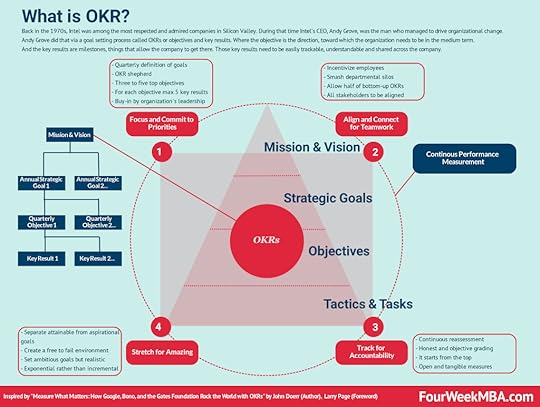 Andy Grove, helped Intel become among the most valuable companies by 1997. In his years at Intel, he conceived a management and goal-setting system, called OKR, standing for “objectives and key results.” Venture capitalist and early investor in Google, John Doerr, systematized in the book “Measure What Matters.”
Andy Grove, helped Intel become among the most valuable companies by 1997. In his years at Intel, he conceived a management and goal-setting system, called OKR, standing for “objectives and key results.” Venture capitalist and early investor in Google, John Doerr, systematized in the book “Measure What Matters.” Operational planning defines how human, financial, and physical resources will be allocated to achieve strategic objectives. That should answer some key questions such as what are the strategies that need to be completed? Who has responsibility for each task? When should the task be completed? What is the timeline? How should progress be measured? How many resources have been allocated to task completion?
Operational planning defines how human, financial, and physical resources will be allocated to achieve strategic objectives. That should answer some key questions such as what are the strategies that need to be completed? Who has responsibility for each task? When should the task be completed? What is the timeline? How should progress be measured? How many resources have been allocated to task completion?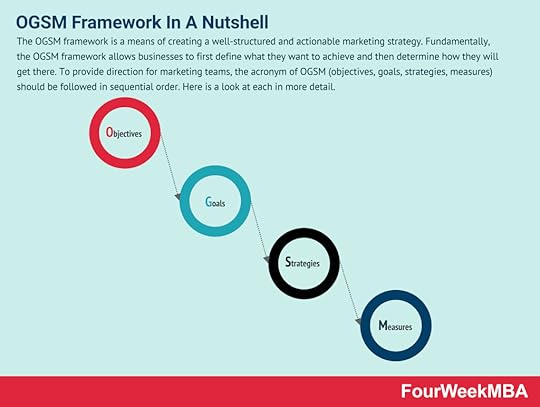 The OGSM framework is a means of creating a well-structured and actionable marketing strategy. Fundamentally, the OGSM framework allows businesses to first define what they want to achieve and then determine how they will get there. To provide direction for marketing teams, the acronym of OGSM (objectives, goals, strategies, measures) should be followed in sequential order. Here is a look at each in more detail.
The OGSM framework is a means of creating a well-structured and actionable marketing strategy. Fundamentally, the OGSM framework allows businesses to first define what they want to achieve and then determine how they will get there. To provide direction for marketing teams, the acronym of OGSM (objectives, goals, strategies, measures) should be followed in sequential order. Here is a look at each in more detail.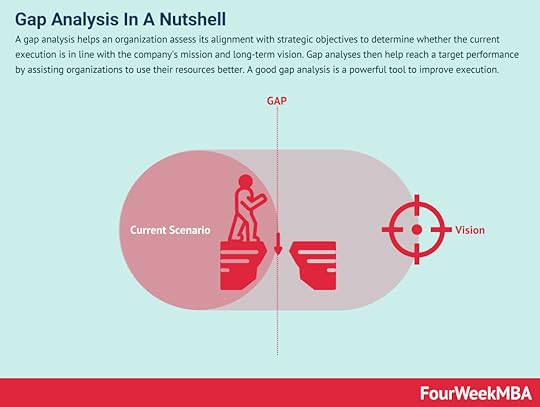 A gap analysis helps an organization assess its alignment with strategic objectives to determine whether the current execution is in line with the company’s mission and long-term vision. Gap analyses then help reach a target performance by assisting organizations to use their resources better. A good gap analysis is a powerful tool to improve execution.
A gap analysis helps an organization assess its alignment with strategic objectives to determine whether the current execution is in line with the company’s mission and long-term vision. Gap analyses then help reach a target performance by assisting organizations to use their resources better. A good gap analysis is a powerful tool to improve execution.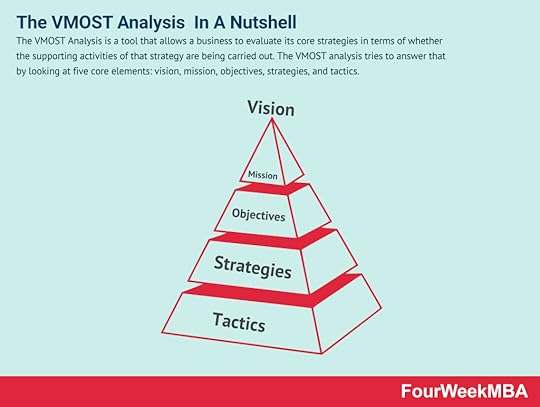 The VMOST Analysis is a tool that allows a business to evaluate its core strategies in terms of whether the supporting activities of that strategy are being carried out. The VMOST analysis tries to answer that by looking at five core elements: vision, mission, objectives, strategies, and tactics.
The VMOST Analysis is a tool that allows a business to evaluate its core strategies in terms of whether the supporting activities of that strategy are being carried out. The VMOST analysis tries to answer that by looking at five core elements: vision, mission, objectives, strategies, and tactics.Main Free Guides:
Business ModelsBusiness StrategyBusiness DevelopmentDigital Business ModelsDistribution ChannelsMarketing StrategyPlatform Business ModelsRevenue ModelsTech Business ModelsBlockchain Business Models FrameworkThe post Critical Success Factors In A Nutshell appeared first on FourWeekMBA.
Maslow’s Hammer: Understanding The Einstellung Effect
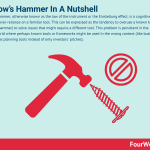
Maslow’s Hammer, otherwise known as the law of the instrument or the Einstellung effect, is a cognitive bias causing an over-reliance on a familiar tool. This can be expressed as the tendency to overuse a known tool (perhaps a hammer) to solve issues that might require a different tool. This problem is persistent in the business world where perhaps known tools or frameworks might be used in the wrong context (like business plans used as planning tools instead of only investors’ pitches).
Understanding Maslow’s HammerMaslow’s Hammer was named after prominent psychologist Abraham Maslow, who said “I suppose it is tempting, if the only tool you have is a hammer, to treat everything as if it were a nail.”
In other words, a hammer is not the most appropriate tool in every situation. But this does not stop a person (armed only with a hammer) from trying to solve different problems with the same solution. What’s more, the person with a hammer may not consider other options and resist looking for a better alternative.
Maslow’s Hammer is a solution-based heuristic, otherwise known as a mental shortcut. Individuals tend to use familiar tools to get what they want without first determining if the tool is right for the job. This is also true of a newly acquired skill, where the individual tends to believe the skill can be applied almost anywhere.
In business, Maslow’s Hammer can manifest in leaders who persist with ineffective leadership styles that no longer work in the present environment. It is also occupation-specific. For example, surgeons believe surgery is the best choice. Psychiatrists believe medication is optimal, while psychologists believe in cognitive behavioral therapy above anything else.
Why does Maslow’s Hammer occur?To explain the mechanisms behind Maslow’s Hammer, consider these two factors:
Déformation professionnelle – a French term describing a cognitive bias where people tend to view the world through the lens of their profession. Although we touched on this in the previous section, it’s important to note that individuals with a certain area of expertise also try to apply their specific skill-sets to non-related contexts.Einstellung effect – another cognitive bias from the German word for “attitude”. This effect explains why past experiences prevent the individual from reaching the best solution to a current problem. While prior problem-solving experience may be relevant to a current problem, there are no guarantees. It is always better to approach a problem objectively and from multiple angles.Avoiding Maslow’s HammerAvoiding Maslow’s Hammer means developing the ability to recognize cognitive biases in ourselves and other people.
Here are some simple ideas:
Observe the tendencies of others – look for instances where a trusted professional offers a narrow range of solutions based on their expertise.Observe your own tendencies – how many times have you tried to fit a square peg into a round hole? Journal your responses and note how you might do better next time.Expand your skillset – if you are also a professional, broaden your perspectives by attending industry seminars or training sessions. What are the best practices in your field and how many disciplines do these practices incorporate?Ask a friend – friends, family, and colleagues are often the best judge of whether we suffer from Maslow’s Hammer. Some people may have difficulty in posing these questions to others for fear of reprisal, but the rewards are worth it.Maslow’s Hammer In The Business WorldThe tendency to overuse tools and frameworks in the business world is pretty common. There are several reasons for that. One example is how entrepreneurs might use a tool like the business plan in the wrong context or understand why they are using it. For instance, the business plan might be a great tool to pitch to investors. However, not necessarily to execute a business strategy.
Indeed, a business plan might contain many assumptions, which are fine as investors want to understand how an entrepreneur reasons in terms of market size. However, these assumptions might be too risky when it comes to execution. For instance, an entrepreneur might assume that a business might work in several contexts in a business plan, but before going there, these need to be tested.
Think, for instance, what would have happened if Amazon didn’t start to execute from books and instead would have tried to expand all over the places too quickly (like Webvan did). Thus, it’s critical to be tool and framework agnostic in the business world and understand that different tools have different purposes.
Maslow’s Hierarchy of Needs Maslow’s Hierarchy of Needs was developed by American psychologist Abraham Maslow. His hierarchy, often depicted in the shape of a pyramid, helped explain his research on basic human needs and desires. In marketing, the hierarchy (and its basis in psychology) can be used to market to specific groups of people based on their similarly specific needs, desires, and resultant actions.Key takeaways:Maslow’s Hammer is a solution heuristic causing an individual to have an over-reliance on a single tool for many different problems. It was first mentioned by prominent psychologist Abraham Maslow.Maslow’s Hammer is caused by a couple of cognitive biases. The first involves individuals trying to solve problems through the lens of their specific skillset. The second bias argues that individuals will default to solving current problems based on how they solved past problems.Maslow’s Hammer can be avoided by developing an awareness of cognitive biases at play in ourselves and others. Broadening one’s personal and professional perspectives is also very effective.
Maslow’s Hierarchy of Needs was developed by American psychologist Abraham Maslow. His hierarchy, often depicted in the shape of a pyramid, helped explain his research on basic human needs and desires. In marketing, the hierarchy (and its basis in psychology) can be used to market to specific groups of people based on their similarly specific needs, desires, and resultant actions.Key takeaways:Maslow’s Hammer is a solution heuristic causing an individual to have an over-reliance on a single tool for many different problems. It was first mentioned by prominent psychologist Abraham Maslow.Maslow’s Hammer is caused by a couple of cognitive biases. The first involves individuals trying to solve problems through the lens of their specific skillset. The second bias argues that individuals will default to solving current problems based on how they solved past problems.Maslow’s Hammer can be avoided by developing an awareness of cognitive biases at play in ourselves and others. Broadening one’s personal and professional perspectives is also very effective.Main Free Guides:
Business ModelsBusiness StrategyBusiness DevelopmentDigital Business ModelsDistribution ChannelsMarketing StrategyPlatform Business ModelsRevenue ModelsTech Business ModelsBlockchain Business Models FrameworkThe post Maslow’s Hammer: Understanding The Einstellung Effect appeared first on FourWeekMBA.



